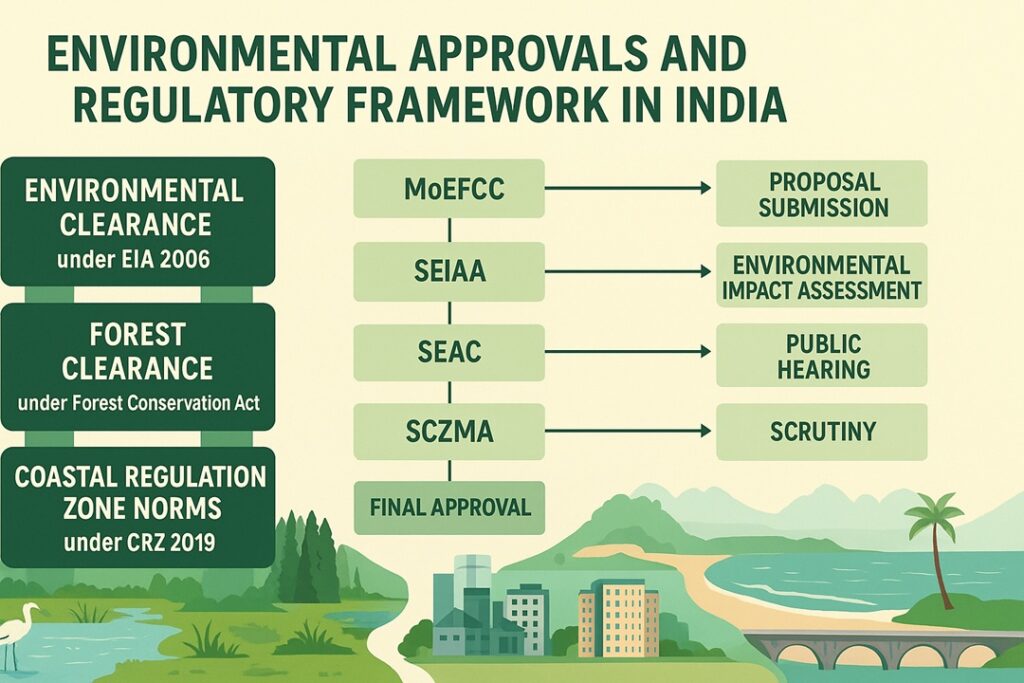Environmental Approvals and Regulatory Framework in India

Context
A real estate project reportedly emerging within the Pallikaranai marshland in Chennai a Ramsar-designated wetland has renewed debate over how large development projects obtain environmental permissions and whether current regulatory processes adequately protect ecologically fragile ecosystems.
Environmental Clearance EC
Legal Basis
First, EC functions under the Environment Impact Assessment Notification 2006 issued under the Environment Protection Act and applies to projects that may significantly alter land use or ecological systems.
Projects Requiring EC
Second, large housing complexes industrial estates power plants mines and major infrastructure projects require EC. Residential or commercial projects with built-up areas above twenty thousand square metres must obtain prior clearance.
Submission Stage
Third, the process begins with submission of detailed project information including site characteristics intended activities and projected impacts.
Screening and Scoping
Fourth, expert appraisal committees determine whether the project requires detailed assessment and define the scope of necessary studies.
EIA and Public Participation
Fifth, a comprehensive Environmental Impact Assessment is prepared and followed by a public hearing to record community concerns and inputs.
Appraisal and Clearance
Sixth, the appraisal committee reviews the report and recommends approval or rejection. SEIAA or MoEFCC then issues the final clearance often with conditions relating to waste management flood mitigation and green cover protection.
Categorisation of Projects
Seventh, Category A projects large or located in sensitive zones are evaluated at the national level by MoEFCC while Category B projects are assessed by SEIAA based on technical review by SEAC.
Validity
Eighth, EC remains valid for seven years and must be renewed if the project is delayed.
Coastal Regulation Zone CRZ Clearance
Legal Basis
First, CRZ approvals are governed by the Coastal Regulation Zone Notification 2019.
Regulated Areas
Second, the norms apply to areas within five hundred metres of the high tide line and tidal water bodies such as creeks and estuaries.
Projects Requiring CRZ Clearance
Third, coastal activities including ports tourism infrastructure pipelines roads and power plants require CRZ permission.
Scrutiny by Authorities
Fourth, SCZMA checks if the project site falls within regulated zones using approved CRZ maps.
Final Approval
Fifth, major construction proposals or those located in the ecologically sensitive CRZ I category require approval from MoEFCC.
Relevance to Pallikaranai
Sixth, CRZ rules do not apply to the inland Pallikaranai wetland but are mandatory for projects along Chennai’s coastline.
Forest Clearance
Legal Basis
First, diversion of forest land is regulated by the Forest Conservation Act 1980 and applies to reserve protected and deemed forests recorded as forest land.
Proposal Requirements
Second, the proponent must submit land details and a compensatory afforestation plan to the State Forest Department.
Scrutiny and Forwarding
Third, state authorities review the proposal and forward it to the Forest Conservation Division of MoEFCC.
Approval Authority
Fourth, regional offices clear proposals involving up to forty hectares while larger or sensitive cases are decided by the central ministry.
Restrictions in Wetlands and Ramsar Sites
Fifth, construction and reclamation are prohibited in wetlands and Ramsar sites under the Wetlands Conservation and Management Rules 2017. Such proposals must be examined by the State Wetland Authority and MoEFCC.
Conclusion
India’s environmental approval framework aims to balance development with ecological protection through layered clearances for land use change forest diversion and coastal activities. However gaps in mapping overlapping jurisdictions and varied interpretation of environmental rules often weaken enforcement. Strengthening regulatory clarity institutional coordination and scientific assessment is essential for sustainable development and ecological resilience.
Source : The Hindu
